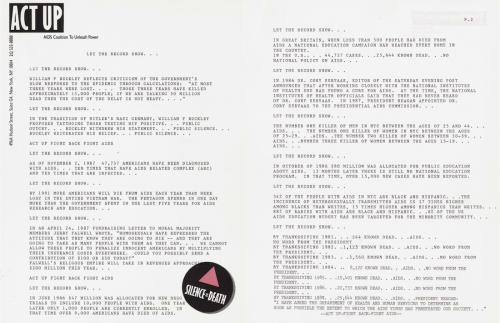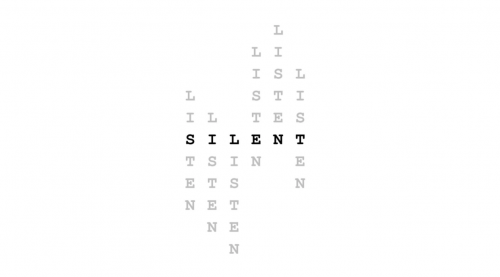The AIDS crisis: a crisis of homophobia, racism, and poverty; a crisis of social stigmatisation and public indifference; a crisis of religious bigotry, big pharma greed, and government inaction. In November 1987, members of the then eight-month-old grassroots organisation ACT UP (self-described as ‘a nonpartisan group of diverse individuals united in anger and committed to direct action to end the AIDS crisis’) installed Let the Record Show… in a street-level window of the New Museum of Contemporary Art in downtown New York.
Part of the installation included an LED display with text presenting facts about the crisis and the political negligence that was shaping its horrors. The text ends with the chilling silence of President Reagan, who remained unresponsive for years as thousands died from the epidemic. 1981, 1982, 1983, 1984, 1985, 1986, ‘no word from the president.’ In 1987, with 25,644 known dead in the US, the record shows that Reagan announces ‘I have asked the department of health and human services to determine as soon as possible the extent to which the AIDS virus has penetrated our society.’ Let the record show the silence, and all the death that went with it. At the top of ACT UP’s window installation, a neon graphic glowed with the words SILENCE=DEATH.
From ACT UP’s Let the Record Show… installation at the New Museum of Contemporary Art, 1987. Source: The New Museum’s Print & Ephemera collection.
In the first decade of the twenty-first century, the audio art/activist group Ultra-red undertook a series of projects which explored practices of listening, remembrance, and what they called ‘organising the silence,’ in the wake of the most prominent years of the AIDS activist movement.[i] The group was originally formed in 1994 by AIDS activists Dont Rhine and Marco Larsen, and several members were involved with re-launching a Los Angeles chapter of ACT UP in 2004. In order to ‘construct spaces in which our loss and grief can acquire a critical language directed against dehumanisation,’ Ultra-red wrote in a 2005 essay, they sought to produce work that ‘suspends resolution and that employs duration.’[ii]
Ultra-red have recalled that their thinking on silence at this time was informed in part by the different conceptions of silence they encountered in the work of the radical educator and philosopher Paulo Freire. In his early writings on critical pedagogy, Freire described the ‘culture of silence’ that had to be broken, for the liberation of the dispossessed to be realised. Much later in his life, though, Freire also introduced another notion of silence, when he wrote about teachers adopting a ‘discipline of silence’ that would support the conditions of listening.[iii]
For their AIDS Uncanny series in the mid-2000s, Ultra-red made a number of audio works that were concerned with what they termed ‘articulating silence.’[iv] Rather than only being understood in terms of erasure and oppression, silence was approached here as something that could be actively deployed, as an affective space, and as a critical tool. As they wrote at the time, ‘The equation, Silence=Death compels us to fill the silence with voices. However, silence is itself a voice: an object that conditions our interventions whether they be screams of lamentation, rage and its pleasures, or some other action pieced from our current affective state.’[v]
During this time, Ultra-red started to work with John Cage’s ‘silent composition’ 4’33” (1952), re-purposing its durational frame by performing it with a mic in hand at various sites of queer resistance and protest. Recordings from these ‘performances’ feature on the album An Archive of Silence, which was released in 2006 as a free download on Public Record.[vi] Some of the tracks on the album are precisely four minutes and thirty three seconds long; some feature the sounds of protestors chanting ‘silence equals death.’ At the end of the final track, An Epidemic of Silence (4’33”), the voice of John Cage announces, ‘this is the kind of music anyone can make, all you have to do is open your ears and listen.’
The question of how to remember the past while also being able to listen in and to the present was a central concern of Ultra-red’s AIDS Uncanny series – the subtitle for which was time for the dead to have a word with the living. ‘[H]ow grateful would the dead be of our remembrances if we close our ears to the context we occupy at this moment?’ the group asked. ‘Perhaps it is in the nature of remembrance and the affects which demand its labor that our imagination closes itself off from today’s conditions around the crisis.’[vii]
An Archive of Silence is not an archive of empirical content that was fixed into a state of retrievability. In its attunement to present resonance, it’s an archive full of ambience, indeterminacy, and absence. Throughout the tracks on the album, voices are muffled and fragmentary, broken off and looped, sometimes abruptly taken over by white noise. Rather than trying to fill in the gaps of the historical record, this is an approach to archiving that foregrounds its own incompleteness; the result, as the artist Terre Thaemlitz has described it, is ‘an archive of the lack of archive.’[viii]
One of the most moving tracks on An Archive of Silence is A Time to Remember, which is composed entirely of the sounds of different inhalations, arranged into a song. These extra-linguistic resonances––breaths taken before, between or instead of speaking––would usually be counted as silences in the historical record, which is to say they would not be counted at all. But when excerpted and made into a rhythm of their own, they are a reminder of the languages that are developed at the edges, and in the gaps, of the official narrative.
Another release in the AIDS Uncanny series was the compilation album A Silence Broken (2006), which drew on Ultra-red’s recordings from their performance of 4’33” at a queer protest in LA in the year 2000.[ix] A number of queer artists – Soft Pink Truth, Lesbians on Ecstasy, Terre Thaemlitz, Miau Miau TM, Jack Tactic, Death Drive and Pet Shop Beuys – were invited to contribute, with tracks that sampled, remixed or otherwise responded to the field recordings. Across the album, electronic dance music is shot through with the voices of protestors singing ‘silence equals death’ in unison.
‘What do you want people to do with this record?’ an interviewer asked Ultra-Red’s Dont Rhine when A Silence Broken came out. His answer: ‘Radical, ecstatic, critical bodily engagement. Our struggles begin on the surface of the skin.’ According to Rhine, the point was not to communicate a predetermined political message. ‘I am more interested in how music already activates us socially, sexually, intellectually, aesthetically,’ he said. ‘I see all these modes of being – structures of feeling, if you will – as having political currency.’[x]
SILENT|LISTEN graphic courtesy of Ultra-red.
.
SILENT|LISTEN (2005-06) was another Ultra-red work which repurposed Cagean silence as a tool for processing and constituting records of the AIDS crisis. For this project, a series of public meetings were held in art museums and institutions across the US and Canada, bringing together people living with HIV and AIDS, local community organisers, activists, and health-care professionals. Each meeting opened with a ‘performance’ of Cage’s 4’33”, which meant that all present would sit together in silence. Participants would then ‘evaluate the silence’ together, before being invited ‘to enter into the record statements on the AIDS epidemic: where it has been, where it is now, and where it is going.’[xi]
As audio recordings of their statements were made, a fragmentary oral history archive was gradually built up, out of the space of silence. Ultra-red have recalled how the shared listening experience could become ‘a collective object of reflections that binds together those who participate.’[xii] At the same time, they have also described how the range of responses provoked at these meetings would underscore the widely varied and often competing ‘frames of reference, political investments, and strategies of listening’ that were available within the group.[xiii]
Some participants found the silence to be a meditative space; some found it frustratingly awkward and confusing. Some were familiar with the experience of sitting together in silence from religious settings; some knew it from medical contexts, where indefinitely long periods of waiting are involved. Some were aware of 4’33”as a canonical work of avant-garde music; some were not. Some noted how the silence made them more aware of the presence of the other bodies around them; some observed that the silence amplified the sounds of the surrounding art space, and of the city beyond its walls.[xiv]
The title of this project, SILENT|LISTEN, played on the fact that the word ‘silent’ and the word ‘listen’ are anagrammatic rearrangements of each other. In Ultra-red’s graphic, seen above, the word ‘silent’ is spelled out horizontally, and the word ‘listen’ repeatedly intersects it with each of the letters on a vertical axis. The intersections tell us that these two forces run through each other in multiple ways: silence is a precondition for listening, while listening to what is not there, or not meant to be there, can allow for things to be heard in new ways. Silence becomes a shelter in which to meet; not just an emptiness waiting to be filled, but also an invitation to develop new listening practices.
This article was published in the ‘silence’ issue of Simulacrum journal, in the Spring of 2021.
[i] See Ultra-red, ‘Organizing the Silence’ in On Horizons: A Critical Reader in Contemporary Art, ed. Maria Hlavajova, Simon Sheikh, and Jill Winder (Utrecht: BAK, basis voor actuele kunst 2011), 192-209. I also discuss silence in Ultra-red’s work in my essay ‘Organise the Silence’, published in the book Master of Voice, ed. Lisette Smits, (Amsterdam/Berlin: Sandberg Instituut/Sternberg Press, 2020, and some passages from that chapter have been reworked for this text.
[ii] Ultra-red, “Time for the Dead to have a Word with the Living: The AIDS Uncanny,” The Journal for Aesthetics & Protest 4, (February 2005).
[iii] Ultra-red, “Organizing the Silence,” 209.
[iv] Liner notes for Ultra-red’s An Archive of Silence, accessed 10 January 2021. For more downloads in the AIDS Uncanny series see Public Record: Archive.
[v] Ibid.
[vii] Ultra-red, “Time for the Dead to have a Word with the Living”.
[viii] Terre Thaemlitz, “Please tell my landlord not to expect future payments because Attali’s theory of surplus-value-generating information economics only works if my home studio’s rent and other use-values are zero” (2008).
[ix] Ultra-red, A Silence Broken.
[x] Electronic Queer: Broken Silences, XLR8R.
[xi] Ultra-red, SILENT|LISTEN (The Record). The phrase ‘evaluate the silence’ comes from Ultra-red’s reports on the meetings.
[xii] Ultra-red, “Organizing the Silence,” 193.
[xiii] Ibid., 201.
[xiv] Ibid.

